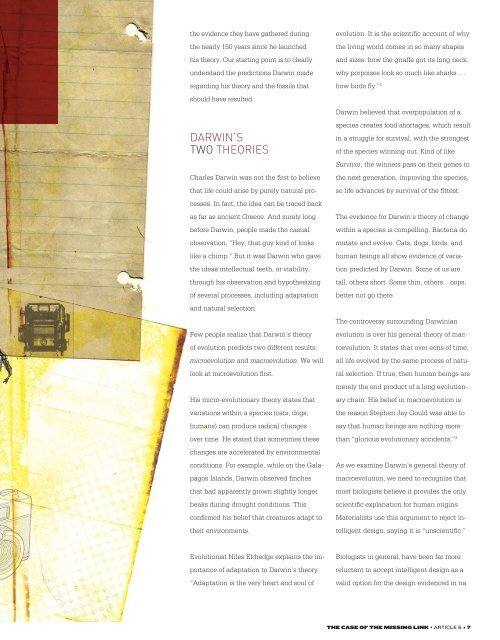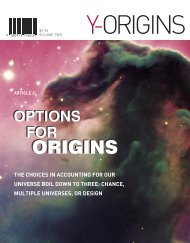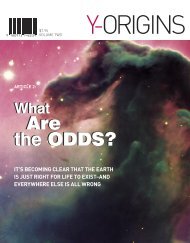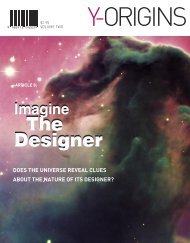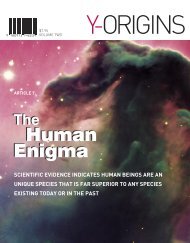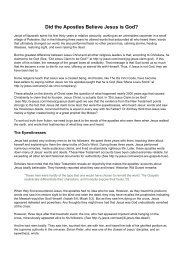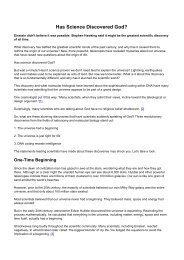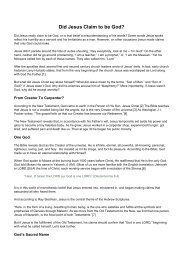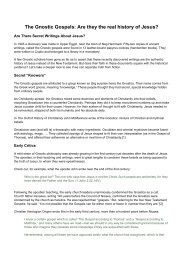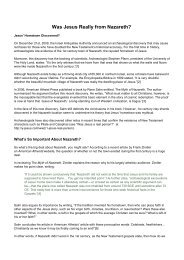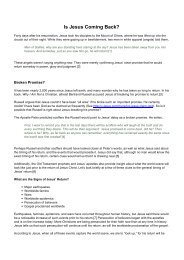missing_link6
Create successful ePaper yourself
Turn your PDF publications into a flip-book with our unique Google optimized e-Paper software.
the evidence they have gathered during<br />
the nearly 150 years since he launched<br />
his theory. Our starting point is to clearly<br />
understand the predictions Darwin made<br />
regarding his theory and the fossils that<br />
should have resulted.<br />
DARWIN’S<br />
TWO THEORIES<br />
Charles Darwin was not the first to believe<br />
that life could arise by purely natural processes.<br />
In fact, the idea can be traced back<br />
as far as ancient Greece. And surely long<br />
before Darwin, people made the casual<br />
observation, “Hey, that guy kind of looks<br />
like a chimp.” But it was Darwin who gave<br />
the ideas intellectual teeth, or viability,<br />
through his observation and hypothesizing<br />
of several processes, including adaptation<br />
and natural selection.<br />
Few people realize that Darwin’s theory<br />
of evolution predicts two different results:<br />
microevolution and macroevolution. We will<br />
look at microevolution first.<br />
His micro-evolutionary theory states that<br />
variations within a species (cats, dogs,<br />
humans) can produce radical changes<br />
over time. He stated that sometimes these<br />
changes are accelerated by environmental<br />
conditions. For example, while on the Galapagos<br />
Islands, Darwin observed finches<br />
that had apparently grown slightly longer<br />
beaks during drought conditions. This<br />
confirmed his belief that creatures adapt to<br />
their environments.<br />
evolution. It is the scientific account of why<br />
the living world comes in so many shapes<br />
and sizes: how the giraffe got its long neck,<br />
why porpoises look so much like sharks …<br />
how birds fly.” 2<br />
Darwin believed that overpopulation of a<br />
species creates food shortages, which result<br />
in a struggle for survival, with the strongest<br />
of the species winning out. Kind of like<br />
Survivor, the winners pass on their genes to<br />
the next generation, improving the species,<br />
so life advances by survival of the fittest.<br />
The evidence for Darwin’s theory of change<br />
within a species is compelling. Bacteria do<br />
mutate and evolve. Cats, dogs, birds, and<br />
human beings all show evidence of variation<br />
predicted by Darwin. Some of us are<br />
tall, others short. Some thin, others…oops,<br />
better not go there.<br />
The controversy surrounding Darwinian<br />
evolution is over his general theory of macroevolution.<br />
It states that over eons of time,<br />
all life evolved by the same process of natural<br />
selection. If true, then human beings are<br />
merely the end product of a long evolutionary<br />
chain. His belief in macroevolution is<br />
the reason Stephen Jay Gould was able to<br />
say that human beings are nothing more<br />
than “glorious evolutionary accidents.” 3<br />
As we examine Darwin’s general theory of<br />
macroevolution, we need to recognize that<br />
most biologists believe it provides the only<br />
scientific explanation for human origins.<br />
Materialists use this argument to reject intelligent<br />
design, saying it is “unscientific.”<br />
Evolutionist Niles Eldredge explains the importance<br />
of adaptation to Darwin’s theory:<br />
“Adaptation is the very heart and soul of<br />
Biologists in general, have been far more<br />
reluctant to accept intelligent design as a<br />
valid option for the design evidenced in na<br />
THE CASE OF THE MISSING LINK • ARTICLE 6 • 7


